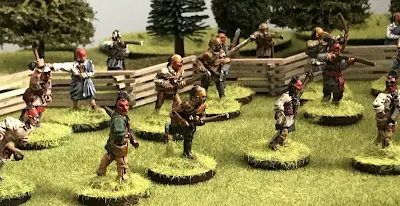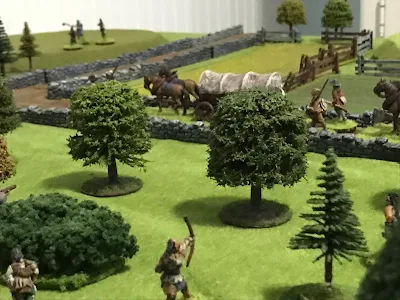I have been playing around with the rules I use for my King Philips War games. I am looking for a simple set of rules which gives a flavor if the period. Most English settlers were poorly trained militia. The better trained Rangers were few and came about late in the war. I call them volunteers to distinguish from militia. Indians were not supermen. If charged they tended to retreat and charged if it was to their advantage. In addition because they tended to avoid heavy casualties their morale was brittle.
I recently found a set of rules by Richard Barbuto on the The Lone Warrior site which looked good. After a few modifications on my part I will be giving them a try.
If interested in them here is a link to the original set called " From Bunker Hill to New Orleans. "
https://lonewarriorswa.com/complete-rule-sets
Of course I will be writing up a game using them soon.
Fighting King Philip
Organization:
All units of 8 - 12 figures. One figure in unit is A leader. All figures are individually mounted.
Each side gets 1 group leader or commander.
Formations:
Line: two ranks base to base.
Column: two figures wide three or more ranks deep. Only first two ranks can fire.
Skirmish Order: single line of figures all touching.
Open Order: single or two ranks. All figure spaces one figure apart. All can fire
Mass: group of figures as wide as deep. Only two ranks can fire.
Sequence of play:
Turns are UGIO. Roll dice for which side goes first.
Next roll D6 for each unit for side movin. This gives # operations for all units that turn.
Indians: 1,2=1 / 3,4=2 /5,6= 3
Militia: 1-3= 1 / 4,5= 2 / 6=3
Volunteers: 1,2=1/ 3-5= 2/ 6=3
Operations:
Move/change formation/change facing
Rally or reform
Load/ Fire
Movement:
Volunteer = 10" column/ 6" line/ 8" open order/ 10" skirmish order
Militia = 10" column/ 6" line/ 8" open order/ 10" skirmish or mass.
Indians= 12" skirmish order/ 10" mass
Terrain:
Roads: add 50% to move if start on road in column.
Hills: All movement up hill except in skirmish order is halved.
Open Woods: deduct 50% movement unless in skirmish
Thick woods: deduct 50% all movement.
Spotting in woods: stationary units spotted at 8"/ moving units or units that fired at 12". Cannot fire at target unless you can see them.
Fire Combat:
All firing is straight ahead. Routed or disordered units cannot fire unless rallied and reformed which takes two operations.
Target classes:
A: Formed Troops in open
B: Formed in woods/ skirmish in open
C: Formed in Thick woods/skirmish in woods
D: Skirmish in Thick woods/behind fence, breast work, low wall, etc...
E. Garrison house or Fort.
Roll D10 per figure firing. Match range to target and must roll that number or less to hit.
Firer. Range. A. B. C. D. E.
Militia 8". 5. 4. 3. 2. 1
Volunteer 8". 5. 4. 4. 3. 2
Indian. 8". 5. 4. 3. 2. 1
Bow. 4". 6". 5. 4. 3. 2
For each hit roll D10. On a roll of 10 unit leader is killed.
Charge:
Declare charge. Must be able to move to within 2" of target. Charging unit must be in good morale to charge. Note after melee charger is disordered.
Defender may fire if loaded, charged from front and passed morale check. Attacker checks morale if hit.
If charged home line up figures in formation they were in. May double up figures. Never more then 2 vs 1.
Roll D10 per figure fighting. Add subtract modifiers.
Modifiers:
Superior Leader with unit +2
Defending class D. +2
Defending class E. +3
Additional figure fighting +2
Non Indian charging. +1
Indian in skirmish formation charging +1
Indian in mass formation charging. +2
Figure disordered -1
Attacked from rear or side. -2
Note: in 2 vs 1 only one figure fights and gets +2. Second figure cannot be killed or withdraw but fights second round melee if survived.
Results:
In the case of two figures meleeing with a single figure. Only one of the two figures rolls and it gets the +2 bonus. That second figure does not roll, nor can it be killed or forced to withdraw. It is not a casualty (but would withdraw if the unit lost the morale check described below.)
If a figure’s die roll is twice that of his opponent, then the opponent is killed.
If a figure’s die roll is greater than his opponent’s, but not double, then the opponent withdraws one skirmish move, facing the winner.
If scores are equal, both figures maintain position for the moment.
When all the figures in contact have rolled, count up casualties for both sides (dead and retreats).
The side with the most casualties has lost.
Compare the number of casualties of both sides and apply the morale check results to the losing unit. e.g. if the winning unit had 3 casualties and the losing unit had 5, the difference is 2. The losing unit withdraws two skirmish moves (the surviving figures of the unit remain together.) The unit is disordered but faces its opponent
Morale:
Check morale if takes casualties, charged or charging.
Roll D10 to check must equal if lower to pass.
Volunteers 8
Militia 6
Indians in cover 8
Indians in open 6
Modifiers:
No leader -1
Each 2 casualties that turn -1
Disordered -1
Less then half strength -1
Charged in flank or rear -2
Indians charged -2
Higher level leader attached +1
In class D cover +1
In class E cover +2
Indians charging skirmishers. +1
Indians charging flank or rear +2
If fail check;
By 1 or 2: withdraw # operations that turn by skirmish move rate. Face enemy. Disordered. Takes one operation to reform.
By 3 or 4: withdraw # operations skirmish move rate. Back to enemy. Routed. Takes one operation to rally and one operation to reform. Two operations total.
By 5 or 6: withdraw # operations at skirmish move rate. Back to enemy. Permanent lost one morale level for rest of game. Routed. Takes one operation to rally and one operation to reform. Two operations total.

















































